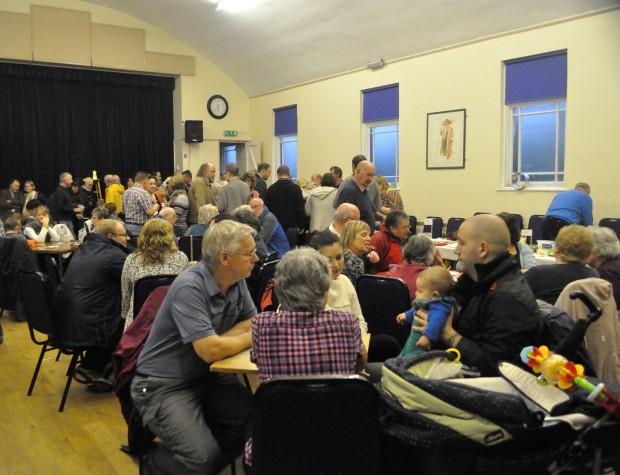A BRIEF HISTORY OF LLANSTEFFAN HALL

The Hall is one of three 1930’s buildings in the village. The imposing height, clean lines, and plain windows, set in stark limestone walls, are all characteristic of the times. The doors are oak with typical heavy fittings. The fine metal lettering above stands proud of the front wall, a clever detail that casts a strong 3D shadow. The plain geometric railings are original while the gate with the Prince of Wales feathers commemorates the 1969 Investiture. Behind the Hall is a sunny garden made by village youngsters for the Millennium. The tiles in the porch are 1930s eau de nil and the original Hall floor was elm boards, good for dancing on. The kitchen facilities were very poor, squeezed by a sloping site into the space beneath the stage, with a surprising hatch-opening in the stage-front through which laden trays and heavy teapots were passed for years until the new kitchen was built in the mid-l990s. At the back of the stage is a mural of the castle and sands painted by a Carmarthen artist.


In the years before the building of the Hall village meetings and concerts were held in a room of Llansteffan’s Victorian school, now a house. By 1937 the vicar was unwilling for either the Church School or the Church Hall opposite The Stores, to be used in this way. A fitting memorial for the Fallen of World War l was needed and this was just the impetus for a Hall to be built, which would be both a memorial and a meeting place.
Mr Stephens “The Grove” generously gave a cottage, one of the village bakeries, in the High Street, as a suitable site in the centre of the village. Mrs Cliff John gave f,500 (she had saved f,50 a year for the last ten years with this plan in mind) and the Carnegie Trust gave f,,450, the remaining f,2000 to be raised by villagers. By 1945 the Hall was free from debt after determined wartime fundraising.


The hall was opened on 5th May 1939 by Miss Stephens, with somber emphasis on the Fallen Heroes whose names were inscribed on the bronze tablets by the door. The Relations of The Fallen and Ex-Servicemen followed the dignitaries into the Hall and all the speakers emphasised the great sacrifices made and the terrible events even then taking place in Europe. Four months later World War 2 broke out. The names of those Llansteffan young men who gave their lives in this second conflict were added to the Memorial after that war.
Llansteffan never forgets that its Hall is its War Memorial; Armistice Day is commemorated in the forecourt every November. At present there is also a four- year project to record the details of each dead soldier from World War l. And, happily, the Hall is the centre of our village social life, used for meetings and functions, fun and entertainment. Almost 80 years of care and good stewardship has given us a Hall to be proud of, to be used, enjoyed and cherished by us all.
